Several videos show police aggressively shoving marchers and using their batons during Sunday’s peaceful march.
By Ashleigh Carter
Published on 6/29/2020

NYPD officers were shown in videos and photos using their batons and pepper spray and shoving peaceful protesters. Credit: Gabriele Holtermann-Gorden/ Reuters
New York City police officers appeared in multiple videos pepper spraying protesters and using aggressive force during a peaceful Pride march on the anniversary of the Stonewall Inn riots that sparked the LGBTQ+ movement. Advocates including GLAAD have condemned law enforcement’s response.
Thousands of people attended the Queer Liberation March for Black Lives Matter and Against Police Brutality on Sunday afternoon, gathering in downtown Manhattan after the city’s annual Pride parade was canceled this year due to coronavirus. Dozens of videos and photos show police officers shoving crowds of marchers and using their batons and pepper spray against demonstrators.
These cops just got ran up on people pic.twitter.com/RnibVPjKfm— Eliel Cruz (@elielcruz) June 28, 2020
NYPD officers are chased off after altercations and arrests with #QueerLiberationMarch protestors in #NYC #NYCPride #nycprotests @SWNS @agreatbigcity pic.twitter.com/Ak7kvMv27J— Adam Gray (@agrayphoto) June 28, 2020
Pepper spray, including of a cop, another falls off a motorcycle, other cops pushing.... at splitter Pride march. pic.twitter.com/kauOXsAwbG— Matthew Chayes (@chayesmatthew) June 28, 2020
Organizers estimated that 50,000 people attended the march.
According to multiple reports, the largely peaceful protests became more violent during a rally in Washington Square Park where police attempted to arrest a man for tagging a cop car with graffiti.
An NYPD spokesperson told NowThis on Monday that officers arrested three people, though a legal observer told Gothamist that police arrested at least four people.
Attendee Mike Perles told Gothamist that before the police arrived at Washington Square Park, marchers were celebrating and dancing.
“We were dancing right in front of the arch on 5th ave and out of nowhere, cops started storming into the crowd,” Perles, who is reportedly a city employee, told Gothamist. “They pushed everyone in front of them out of the way and onto the ground. They pushed a reporter who was taking photos down and started randomly pepper spraying people. I couldn't see anyone instigating. It seemed like they felt out numbered after entering a huge group and panicked and started beating people up.”
The organizers of the march, Reclaim Pride Coalition, put out a statement Sunday calling the NYPD’s intervention in the march “a vast and brutal overreaction.” Organizers also said officers “punched and violently shoved” marchers and slammed a woman on a bicycle to the ground.
“I wish that I could say what I saw today was shocking, but how could I reasonably expect anything else from the NYPD?” Jake Tolan, one of the march organizers, said in the statement. “51 years after the Stonewall Rebellion, the NYPD is still responding to peaceful, powerful, righteous queer joy with pepper spray, batons, and handcuffs.”
We could not have pulled this off without the continued support of our Black & Trans organizers, supporters, endorsers, volunteers, and of course all of you marchers.
THANK YOU ALL!— Reclaim Pride Coalition (@queermarch) June 29, 2020
On the anniversary of the start of the Stonewall riots, the NYPD is attacking LGBTQ people who are marching for Pride. Let that sink in. https://t.co/j4ZL4jMHsa— GLAAD (@glaad) June 28, 2020
The celebration continued into early Monday near the Stonewall Inn, where an uprising in response to police brutality helped ignite the modern Pride movement 51 years ago. On June 28, 1969, police raided the historic gay bar, inciting a days-long riot.
Last year, former NYPD Commissioner James O’Neill apologized on behalf of the NYPD for the actions of police officers that sparked the 1969 riots.
“I do know that what happened at Stonewall should not have happened,” O’Neil said during a 2019 Pride Month community safety briefing. “The actions taken by the NYPD were wrong, plain and simple. The actions and the laws were discriminatory and oppressive, and for that I apologize.”
Several people have criticized New York City Mayor Bill de Blasio for tweeting about his support of the LGBTQ+ community on the anniversary of the movement despite police response to this year’s protests. (De Blasio has been under fire in recent weeks, after he ran on a platform of improving the city’s relationship with police.)
he tweeted this while his cops pepper sprayed the queer liberation march https://t.co/MxHt8sSo9j— alex (@alex_abads) June 28, 2020
Black, brown and white queer and trans Lives were threatened and harmed by police during a peaceful March and protest In NYC today. While the @NYCMayor shared tweets of support of our community the police shared mace pepper spray handcuffs and violent force against us.— Black femme life is precious (@IndyaMoore) June 29, 2020
Shame on @NYCMayor rainbow flags flying at city hall while the police are still beating our folks 50 years later, this was a peaceful march vulnerable communities many who have faced police violence were triggered by this violence you are complicit with the photos speak— BlackTransMedia (@BlackTransMedia) June 29, 2020
Several city officials expressed their disappointment in Sunday’s events, including Manhattan Borough President Gale Brewer and New York City Council Speaker Corey Johnson.
On the 51st anniversary of Stonewall, which should be a time of celebration, I am concerned that in these instances the NYPD failed in their duty to protect NYers & de-escalate. We need answers, especially as we approach a potential budget agreement defining our city’s values. https://t.co/QxhEuFbGLe— Gale A. Brewer (@galeabrewer) June 28, 2020
The first #Pride started as a response to police brutality. Today, peaceful protesters were pepper sprayed on the 51st anniversary of Stonewall. This is incredibly disturbing.
We need a full investigation into what happened today. https://t.co/QpUG9OIej7— NYC Council Speaker Corey Johnson (@NYCSpeakerCoJo) June 29, 2020
Published on 6/29/2020
NYPD officers were shown in videos and photos using their batons and pepper spray and shoving peaceful protesters. Credit: Gabriele Holtermann-Gorden/ Reuters
New York City police officers appeared in multiple videos pepper spraying protesters and using aggressive force during a peaceful Pride march on the anniversary of the Stonewall Inn riots that sparked the LGBTQ+ movement. Advocates including GLAAD have condemned law enforcement’s response.
Thousands of people attended the Queer Liberation March for Black Lives Matter and Against Police Brutality on Sunday afternoon, gathering in downtown Manhattan after the city’s annual Pride parade was canceled this year due to coronavirus. Dozens of videos and photos show police officers shoving crowds of marchers and using their batons and pepper spray against demonstrators.
These cops just got ran up on people pic.twitter.com/RnibVPjKfm— Eliel Cruz (@elielcruz) June 28, 2020
NYPD officers are chased off after altercations and arrests with #QueerLiberationMarch protestors in #NYC #NYCPride #nycprotests @SWNS @agreatbigcity pic.twitter.com/Ak7kvMv27J— Adam Gray (@agrayphoto) June 28, 2020
Pepper spray, including of a cop, another falls off a motorcycle, other cops pushing.... at splitter Pride march. pic.twitter.com/kauOXsAwbG— Matthew Chayes (@chayesmatthew) June 28, 2020
Organizers estimated that 50,000 people attended the march.
According to multiple reports, the largely peaceful protests became more violent during a rally in Washington Square Park where police attempted to arrest a man for tagging a cop car with graffiti.
An NYPD spokesperson told NowThis on Monday that officers arrested three people, though a legal observer told Gothamist that police arrested at least four people.
Attendee Mike Perles told Gothamist that before the police arrived at Washington Square Park, marchers were celebrating and dancing.
“We were dancing right in front of the arch on 5th ave and out of nowhere, cops started storming into the crowd,” Perles, who is reportedly a city employee, told Gothamist. “They pushed everyone in front of them out of the way and onto the ground. They pushed a reporter who was taking photos down and started randomly pepper spraying people. I couldn't see anyone instigating. It seemed like they felt out numbered after entering a huge group and panicked and started beating people up.”
The organizers of the march, Reclaim Pride Coalition, put out a statement Sunday calling the NYPD’s intervention in the march “a vast and brutal overreaction.” Organizers also said officers “punched and violently shoved” marchers and slammed a woman on a bicycle to the ground.
“I wish that I could say what I saw today was shocking, but how could I reasonably expect anything else from the NYPD?” Jake Tolan, one of the march organizers, said in the statement. “51 years after the Stonewall Rebellion, the NYPD is still responding to peaceful, powerful, righteous queer joy with pepper spray, batons, and handcuffs.”
We could not have pulled this off without the continued support of our Black & Trans organizers, supporters, endorsers, volunteers, and of course all of you marchers.
THANK YOU ALL!— Reclaim Pride Coalition (@queermarch) June 29, 2020
On the anniversary of the start of the Stonewall riots, the NYPD is attacking LGBTQ people who are marching for Pride. Let that sink in. https://t.co/j4ZL4jMHsa— GLAAD (@glaad) June 28, 2020
The celebration continued into early Monday near the Stonewall Inn, where an uprising in response to police brutality helped ignite the modern Pride movement 51 years ago. On June 28, 1969, police raided the historic gay bar, inciting a days-long riot.
Last year, former NYPD Commissioner James O’Neill apologized on behalf of the NYPD for the actions of police officers that sparked the 1969 riots.
“I do know that what happened at Stonewall should not have happened,” O’Neil said during a 2019 Pride Month community safety briefing. “The actions taken by the NYPD were wrong, plain and simple. The actions and the laws were discriminatory and oppressive, and for that I apologize.”
Several people have criticized New York City Mayor Bill de Blasio for tweeting about his support of the LGBTQ+ community on the anniversary of the movement despite police response to this year’s protests. (De Blasio has been under fire in recent weeks, after he ran on a platform of improving the city’s relationship with police.)
he tweeted this while his cops pepper sprayed the queer liberation march https://t.co/MxHt8sSo9j— alex (@alex_abads) June 28, 2020
Black, brown and white queer and trans Lives were threatened and harmed by police during a peaceful March and protest In NYC today. While the @NYCMayor shared tweets of support of our community the police shared mace pepper spray handcuffs and violent force against us.— Black femme life is precious (@IndyaMoore) June 29, 2020
Shame on @NYCMayor rainbow flags flying at city hall while the police are still beating our folks 50 years later, this was a peaceful march vulnerable communities many who have faced police violence were triggered by this violence you are complicit with the photos speak— BlackTransMedia (@BlackTransMedia) June 29, 2020
Several city officials expressed their disappointment in Sunday’s events, including Manhattan Borough President Gale Brewer and New York City Council Speaker Corey Johnson.
On the 51st anniversary of Stonewall, which should be a time of celebration, I am concerned that in these instances the NYPD failed in their duty to protect NYers & de-escalate. We need answers, especially as we approach a potential budget agreement defining our city’s values. https://t.co/QxhEuFbGLe— Gale A. Brewer (@galeabrewer) June 28, 2020
The first #Pride started as a response to police brutality. Today, peaceful protesters were pepper sprayed on the 51st anniversary of Stonewall. This is incredibly disturbing.
We need a full investigation into what happened today. https://t.co/QpUG9OIej7— NYC Council Speaker Corey Johnson (@NYCSpeakerCoJo) June 29, 2020
51 Years After Stonewall, New York’s Queer Liberation March Faces Police Violence
This is a moment of reckoning that is knitting together seemingly disparate social movements.
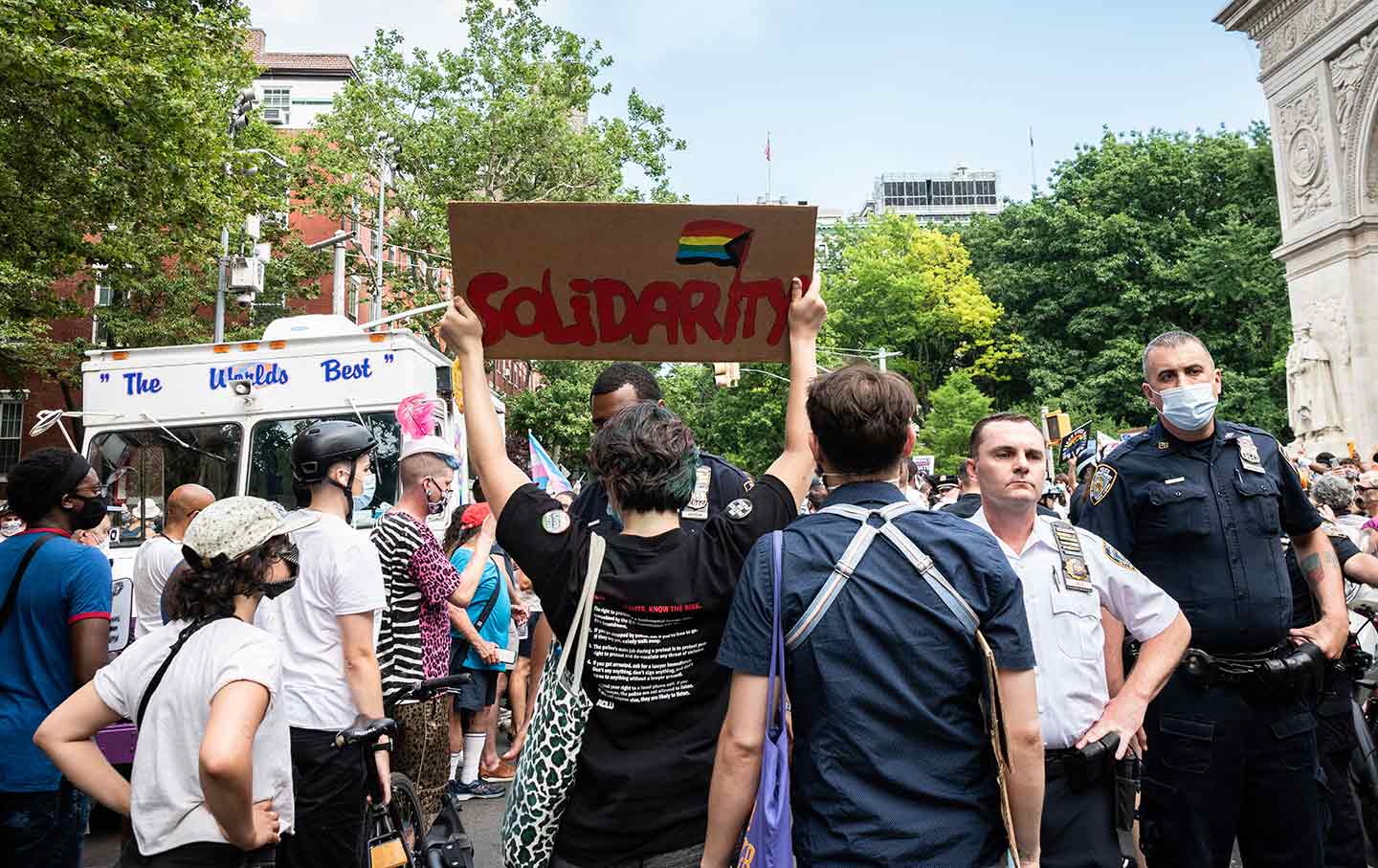
Protesters confront NYPD officers after they arrested a person for disorderly conduct following the Queer Liberation March in New York City. (Gabriele Holtermann / Sipa USA)
At about 4:30 PM on Sunday, June 28, I was both elated and exhausted. After marching for two and a half miles as a lead organizer of the Queer Liberation March for Black Lives and Against Police Brutality, I had taken a short break to rest and replenish near our end point, Washington Square Park. But now I was ready to go back into the post-march celebration in the center of the park. I saw in the distance that there seemed to be a commotion at the north end of the park, near the Washington Square Arch, and started to walk toward it. On my way, I ran into my friend Liz, who told me that the NYPD had pepper-sprayed the tail end of our march and that Sasha Alexander of Black Trans Media, who was running the post-march speak-out at the small stone stage in the middle of the park, had successfully implored the White people viewing the speak-out to form a barrier around the perimeter of the area to protect the Black and Brown and Trans folks speaking and watching. I glanced over at the stage area and saw the line of White faces lined up facing any danger that might be on its way and felt proud to be among these people. Then I headed to the arch. Soon, I saw people on the ground trying to flush their eyes out and ran into my friend Dinetta, who gave me more details on the police’s actions: She had seen cops ramming into protesters with their motor scooters, unleashing pepper spray on the crowd and intentionally escalating tensions. How had we gotten here?
The first Queer Liberation March and rally, held on June 29, Pride Sunday, 2019, had been an on a enormous success. The march’s organizers, the Reclaim Pride Coalition (RPC) had conceived it as an alternative to the mainstream parade, produced by the organization Heritage of Pride. We planned a march that wouldn’t have the overwhelming presence of the NYPD, whose route wouldn’t be fully barricaded, and that would avoid the overweening corporate presence in the traditional Pride parade. In addition, we sought to uplift the voices of the most marginalized communities among our larger LGBTQ+ family. After months of negotiation with the NYPD, the mayor’s office, and the Parks Department, we had successfully produced a march of 45,000 from Seventh Avenue and Christopher Street to the Great Lawn of Central Park, where a rally featuring speeches and performances from a wide swath of largely Black, Brown, Indigenous, Immigrant, Disabled, Deaf and Hard of Hearing, and Neurodivergent LGBTQ+ activists and performers. The long-standing history of police violence against members of these communities and the lasting trauma resulting from it prompted the RPC’s insistence on a minuscule NYPD presence at our march and rally. That goal was with accomplished with no barricading along our march route, which shifted to Sixth Avenue after we departed from Christopher Street, replicating the route of our inspiration, the June 28, 1970, Christopher Street Liberation Day March, the first Pride march, conceived and executed by the Gay Liberation Front.
After that extraordinary success and the appreciation we heard from many of New York City’s queer communities, the Reclaim Pride Coalition recognized a mandate to move forward with plans to replicate that success in 2020. That is, until some lady named Rona came to town and blew our Pride plans for June to smithereens. We quickly decided that we would pursue some virtual programming for Pride Sunday. But by the time we had determined the content we wanted for the livestream, we were hit by a steady stream of shocks to our systems. First, the inaction in response to Ahmaud Arbery’s murder, then the police execution of Breonna Taylor, then a white woman calling the police on birdwatcher Chris Cooper in the Central Park Ramble, and the one-two gut punches of the death of legendary activist Larry Kramer, less than a year after he had delivered an impassioned speech after our inaugural 2019 Queer Liberation March, and the murder of George Floyd by Minneapolis police. Our members and organizers took to the streets in protest. Soon, there was unanimous agreement that we would reconstitute our Pride march in person, not just virtually, one that would be held in the fully intersectional spirit of our organization’s founding. And we had to get all of that done in three and a half weeks.
 Top ArticlesMaya Moore for the Win
Top ArticlesMaya Moore for the Win



 READ MORE00:14/00:30
READ MORE00:14/00:30SKIP AD

Somehow, it worked. After we announced our plans, the NYPD reached out to us through our pro bono attorney, Norman Siegel, who has been a part of our efforts since the fall of 2018. Through Norman, we told them we would not be seeking a permit and they replied that they wouldn’t interfere. We planned to begin in Foley Square in Lower Manhattan and proceed up to the Village passing the Stonewall Inn and ending in Washington Square Park, but we resolved not to reveal our route publicly and only announced our end point on the Friday before the march.
RELATED ARTICLE
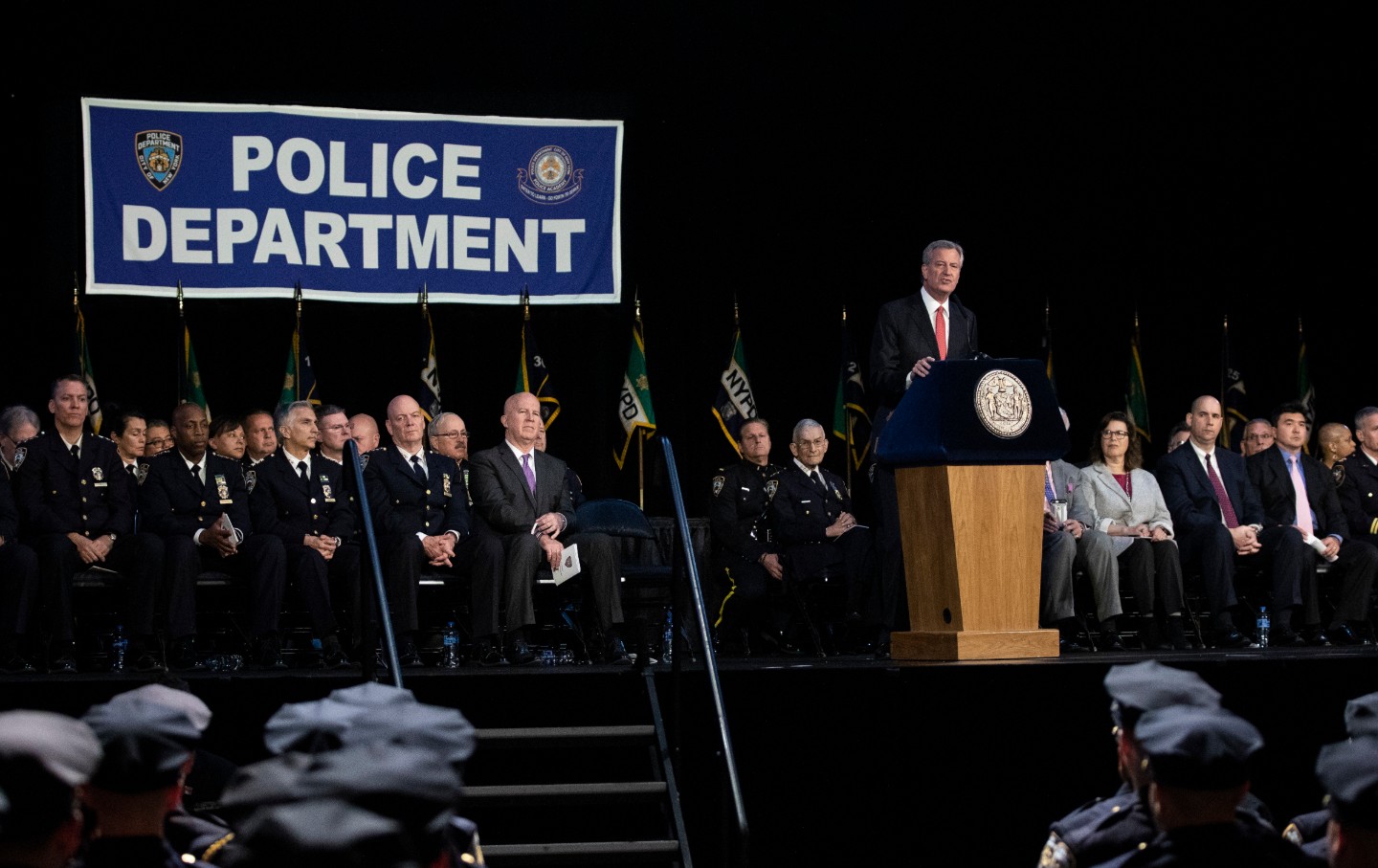
BILL DE BLASIO BROKE HIS PROMISE TO NEW YORK
the Editors
On Sunday morning, we awoke to sunshine and cloudless skies. Our team arrived at Foley Square at 11 AM to prepare. There were almost no cops in sight. We began with brief opening remarks at approximately 12:45 and after pouring libations to our murdered Black and Brown siblings, singer Xavier Smith started the march off with a stirring a cappella rendition of the “Negro national anthem,” “Lift Every Voice and Sing.” We had no difficulties along the march route. At the front of the march, there was almost no visible police presence beyond a couple of unmarked cars driving a couple of blocks ahead to ensure that the streets ahead of us were clear and an experienced plainclothes police liaison marching ahead of the marshals and staying apprised with our decisions along the route. After marching past the Stonewall Inn, we looped back on West 10th Street to Fifth Avenue and then down into Washington Square. Once inside the park, I led the lead marchers over to the small park stage to get things situated for the speak-out. Afterward I took that replenishing break and then reentered the festivities, only to find that the NYPD had caused the end of the march to descend into chaos.
Once I passed the arch, I was relieved to see that our marshals were still there on Waverly Place. I spoke to them and got the details. A truck blaring dance music had joined the rear of the march at some point during the route. That truck parked just west of the arch entrance and an impromptu dance party ensued along Waverly Place and at the bottom of Fifth Avenue. At some point shortly after the dancing began, the hordes of cops—many unmasked and improperly masked—invaded the marchers’ space.
According to several trained RPC marshals who were present throughout the melee, although the NYPD had promised not to interfere with our march, they had decided to amass a large phalanx of officers in the area north and east of the Fifth Avenue entrance to the park. Soon they were arresting a man for scribbling with a black Sharpie on the back of a police car parked nearby. Angered by the sudden police presence after a virtually cop-free march against police brutality, the crowd drew toward the arresting officers chanting, “Let him go!” Perhaps recognizing the fundamental illogic of storming into a space filled with hundreds of New Yorkers who are intent on defunding, dismantling, and abolishing policing as it exists, the cops began to panic. They called for backup and began pushing chaotically into the crowd. Cops on scooters drove directly into marchers. Using pepper spray, billy clubs, and their fists, they attacked anyone within reach, whacking people on their lower legs to cause them to fall, and generally “wilding out.” Fortunately, the trained marshals, led by veteran ACT UP activists Jamie Bauer, Alexis Danzig, and BC Craig, managed to de-escalate the situation, convincing the marchers to sit and squat down to allow people to be able to see. The cops arrested an additional two people whom they themselves had attacked. The protesters began chanting, “Who do you serve? Who do you protect?” Soon, the marchers gave the cops an exit path going west along Waverly Place and the protesters advanced along with them so as not to cede space.
Once the central arch-adjacent area had been cleared of cops, I joined the marshals in directing folks to get out of the street and back onto the sidewalks and into the park. Just as we had the area calm, scores of cops wearing riot gear trooped in marching from east to west along Waverly. The marshals kept people from surging back into the street; but not from reading the riot cops for filth verbally. Within two or three minutes, the riot cops, realizing that their presence was unnecessary and clearly provoking the protesters, exited in the direction from whence they came. Order at least temporarily restored, the lead marshals and I departed to go provide jail support for those arrested at the Sixth Precinct house on West 10th Street. It was only later that we would hear on the news that the NYPD had charged those people they had attacked and arrested with assaulting an officer. It was going to be a long night.
Late in the day on Monday, June 29, after over 24 hours in custody, the three arrestees were released, two with desk appearance tickets and one on bond. But, the further damage to the reputation of the NYPD was undeniable; just as the many instances of horrific brutality and illegal and unwarranted acts of force over the last month have. In this moment of reckoning that has come in the wake of this spring’s police murders of Black Americans, the United States appears to have entered a new phase in the intersectional activism initially prompted by the election of Donald Trump. The three and a half years of resistance, the Women’s March movement, the Dreamer and immigrant rights mMovements, the #MeToo movement, the Extinction Rebellion movement, the Indigenous peoples and sacred lands movement, the HIV/AIDS and health care equity movements, and the March for Our Lives have paved the way for the multiracial, multiethnic, multifaith, multigender, multiply sexually orientated protests that have swept the nation. And all of that work builds on the foundations laid 50 or 60 years ago, the last time we had a similarly broad national reckoning that knitted together seemingly disparate movements like the Gay Liberation Front, the women’s movement, the civil rights movement, the Black Power movement, the farmworkers movement, the anti-war movement, and the environmentalist movement. That period of common-cause activism was allowed to wither and die in the ’80s; but it appears that we may have more stamina in this moment, as well as an ability to connect with each other and maintain our movements digitally in a way that the forces of political and capitalist orthodoxy may not have the wherewithal to undo. This might be the moment that heralds a true opportunity to dismantle the White supremacist patriarchy upon which this country was founded. Can we use our information technology and organizing momentum to make progress quickly so that we are not fractured into our constituent parts again? Well, I suppose that is up to us. The only thing I can be certain of is that the third Queer Liberation March will be held on Pride Sunday, June 27, 2021.
MOST POPULAR
1
‘WE ARE NOT EVEN BEGINNING TO BE OVER THIS PANDEMIC’
2
THE WHITE LEFT NEEDS TO EMBRACE BLACK LEADERSHIP
3
IMAGINING A NEW MOUNT RUSHMORE
4
‘WHAT TO THE SLAVE IS THE FOURTH OF JULY?’ BY FREDERICK DOUGLASS
5
WHAT ARE ART GALLERIES FOR?
Jay WalkerJay W. Walker is an organizer, activist, and cofounder of the Reclaim Pride Coalition. He has conceived, produced, and co-produced numerous fundraising events, public awareness campaigns, rallies and protests focusing on LGBTQ issues, HIV/AIDS (Jay is a longtime HIV survivor), hate crimes, the movement for Black lives, and other issues over the last 20 years.


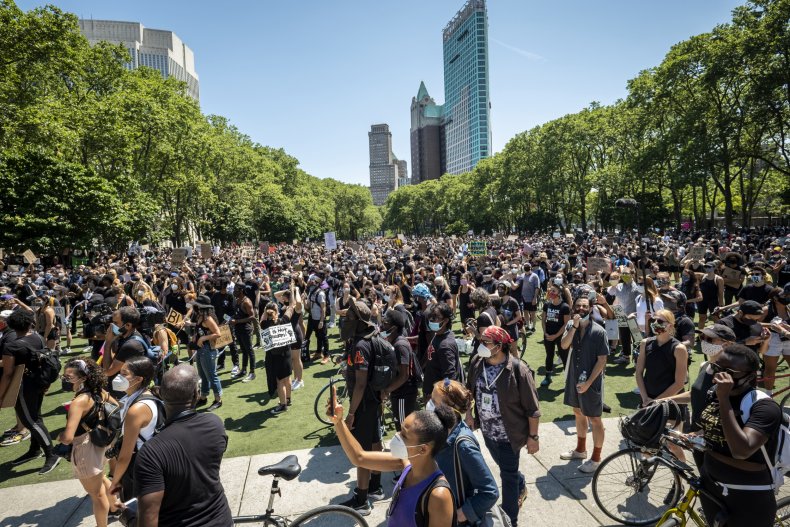
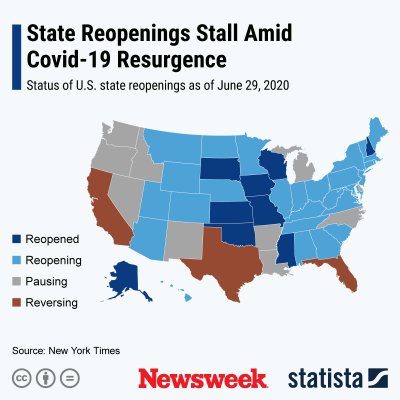 STATISTA
STATISTA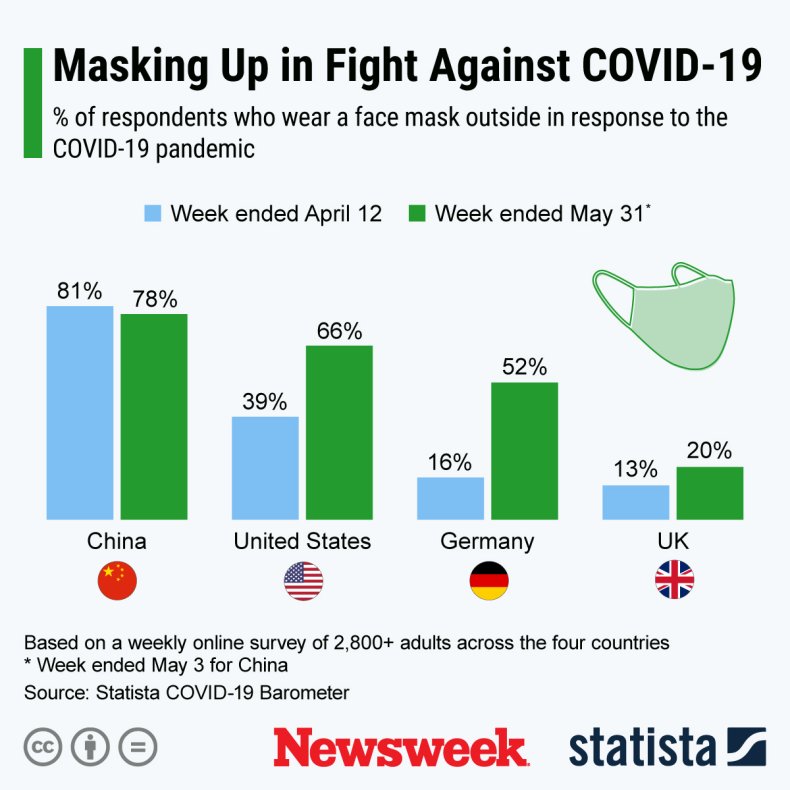 STATISTA
STATISTA A graph comparing newly confirmed COVID-19 cases in the U.S. and Europe.STATISTA
A graph comparing newly confirmed COVID-19 cases in the U.S. and Europe.STATISTA












